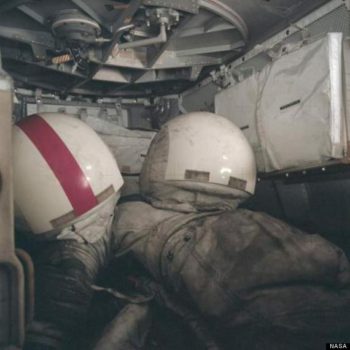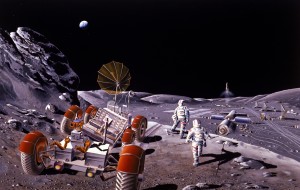
Geologist Harrison Schmitt performs Moon tasks during Apollo 17 mission in December 1972.
Credit: NASA
The Moon is a Disneyland of Dust.
Its pervasive nature was characterized by the last man on Moon, Gene Cernan. He reported after his 1972 Apollo 17 mission: “we can overcome other physiological or physical or mechanical problems except dust”. Dust adhered ‘to everything, no matter what kind of material” with “restrictive, friction-like action,” he explained.
Research by an Australian scientist suggests that dust is the major surface problem for risk management plans of future lunar expeditions – both for humans and robotic explorers.

Apollo 17 helmets and dusty spacesuits stuffed inside lunar lander following the last human treks on the Moon in December 1972.
Credit: NASA
Apollo dust
Brian J. O’Brien of the School of Physics and Astrophysics at the University of Western Australia has taken a retrospective and future look at worrisome “Apollo dust,” sunrise-driven storms of Apollo dust, and other phenomenon. There’s need for a paradigm change from a “culture of dismissal” of the problem to top priority, he suggests.
Apollo dust is defined as all fine dust on and in the vicinity of the surface of Moon that can cause or lead to operational impacts and operational problems for robotic and human expeditions and lunar settlements. Also, ejecta dust is defined as high speed dust particles resulting from hypersonic meteoritic or cosmic dust impacts on the Moon, including secondary products of ejecta.
O’Brien’s research work – “Paradigm shifts about dust on the Moon: From Apollo 11 to Chang’e-4” – is newly published in the journal, Planetary and Space Science.
Risk management
There’s need for a re-examination of risk management of effects of Apollo dust given international expeditions including a Moon Village and private groups headed for the Moon.
Speculated by O’Brien is that lunar dust storms were consistent with being a cause of immobilization of China’s Yutu rover that was dispatched on the Moon in December 2013. Such dust, he notes, may have caused moving parts of Cheng’e-3 Yutu lunar rover to be subjected to the friction-like effects of dust gumming up parts of the robot.
Back in July 1969, O’Brien reports, rocket exhaust from the Eagle’s lunar lander departure blew contaminating dust so large it caused overheating and failure within 21 Earth days of the first science observatory deployed by a human on Moon.
Unfinished business
Studying Apollo dust is “unfinished business,” O’Brien points out. Looking forward, he is hopeful that updated 21st century dust detectors and their data on China’s Chang’e-4 far side lander and perhaps India’s Chandrayaan-2 lander/rover will study movements of Apollo dust.
“With the splendid high technology and miniaturization of cameras and electronic devices,” O’Brien explains, “it may well be that a modern innovation can cause a new paradigm change in understanding Apollo dust.”
Special caution
In concluding remarks, O’Brien has a “special caution” for private entrepreneurs and others “who might assume that dust can be dismissed for any expedition which completes activities on its first lunar day before the first sunrise. Every dust problem and bothersome operational difficulty for every Apollo astronaut occurred on his first lunar day. I enviously wish you all well.”
To read “Paradigm shifts about dust on the Moon: From Apollo 11 to Chang’e-4” — in the journal, Planetary and Space Science, go to:
https://www.sciencedirect.com/science/article/pii/S0032063317302830?via%3Dihub




